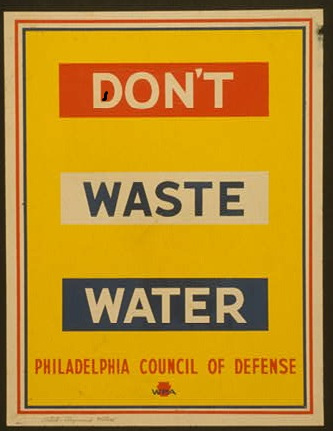 Gaye Levy, Contributing Writer
Gaye Levy, Contributing Writer
Activist Post
Today I would like to once again focus on water.
This time, however, I would like to address those little things you can do now to minimize your household water usage.
Why, you ask? It is my belief that preparedness is a lifestyle and to that end, we need to be proactive and embrace good habits now so when and if a crisis or disaster occurs, these habits will be second nature and intuitive.
So how can you save and conserve household water? We will start with the bathroom and move on from there.
Factoid: Did you know that close to 75% of all household water is used in the bathroom?
1. The faucet at the bathroom sink does not need to be running continuously while you brush your teeth, wash your face or shave. You will save between three and five gallons of water each minute your faucet is turned off. That is a lot of water! Instead, use the stopper on the sink and drain the basin when you are done.
2. Only flush when needed. A toilet is not a wastepaper basket for tissues, cotton balls or other bits of trash.
3. Most toilets installed before 1980 use 5-7 gallons of water per flush. Toilets installed between 1980 and 1993 use 3.5 gallons per flush. Toilets installed since 1994 use 1.6 gallons.
If you happen to have an older toilet, consider filling a used soda bottle or jar with water and small pebbles or marbles and place it upright in the tank. This will cut down on the amount of water that flows through the tank with each flush. Just be careful not to place the bottle where it will jam the flushing mechanism. Also, make sure you don’t displace so much water that you have to double-flush. Double flushing wastes more water than you would save.
4. Check for leaky faucets and toilets. It is easy to replace worn washers — and since a small leak can waste many gallons of water a day, it is well worth the effort to test for leaks now.
The way to test for toilet leaks is to put a few drops of food coloring in the tank to see if the colored water appears in the bowl. This takes about 10 minutes. If it does, you have a leak. Not to worry, though. Most leaks can be repaired with a kit that you can pick up at your local hardware store. You can find lots of information on toilets and toilet repairs at http://www.toiletology.com/.
And remember that little leaks can add up fast. A faucet drip or invisible toilet leak that totals only two tablespoons a minute comes to 15 gallons a day. That’s 105 gallons a week or 5,460 wasted gallons of water a year.
Helpful hint: Are you wondering how long the parts in your toilet tank should last? The answer is: it depends. Replaceable parts such as flappers and washers or seals inside the refill valve may last several years. However factors such as water treatment processes, toilet bowl cleaners, and high water pressure can cause parts to disintegrate much sooner. If you touch the flapper and get black “goo” on your hands, the flapper needs to be replaced.
 5. Check for hidden water leaks elsewhere in your home by reading your water meter. What you do is read the house water meter before and after a two-hour period when no water is being used. If the meter does not read exactly the same, there is a leak.
5. Check for hidden water leaks elsewhere in your home by reading your water meter. What you do is read the house water meter before and after a two-hour period when no water is being used. If the meter does not read exactly the same, there is a leak.
6. Take shorter showers. Bathing and showering consume huge amounts of water. One good way to conserve is to turn the water off while you soap up. I get too cold doing that, so instead I have installed a water-saving shower head. Another option is to limit the length of your shower to 5 minutes or less. Reducing your shower time by 1 minute can save up to 1,000 gallons of water a year!
7. When you take a bath, use lots of bubble bath. I kid you not. Stop up the tub, add a copious amount of bubble bath and and just a few inches of water. It is totally an illusion but it will seem as though the water is higher than it really is. In addition, remember to plug the tub before turning on water; that initial burst of cold water will be warmed later by adding hot water.
8. Do you like drinking cold water? Keep a bottle or carafe of drinking water in the refrigerator so that you don’t let the water from the faucet run while getting a cold drink. This applies only if you drink the water from your tap, of course.
9. In the kitchen, don’t let the faucet run when you scrub vegetables or prepare other foods. Put a stopper in the sink instead. Likewise, do not use running water to thaw meat or other frozen foods. Defrost food overnight in the refrigerator instead.
10. Instead of using a garbage disposal that requires running water to operate, start and use a compost pile. Your garden will love you for it!
11. Most people know that you can leave some water running in order to prevent pipes from freezing in cold weather. Except for the most extreme situations, all you need is a very thin trickle of water running to accomplish that goal.
12. Full loads only, please, when washing your clothes in a washing machine — or your dishes in a dishwasher.
13. Install inexpensive faucet aerators in your bathroom and kitchen. Consider this: If you can bathe your whole body with a shower head that uses less than 2.5 gallons per minute, why use up to 7 gallons just to wash your hands in the sink? An aerator that supplies 2.5 gallons per minute should be fine in the kitchen. In the bathroom, a 1-gallon-per-minute aerator will provide plenty of water to brush your teeth, wash your hands.
14. When watering your plants, deep soak each time you water. Many people water lightly and frequently, causing a shallow root system. Watering deeply and infrequently creates a healthy root system that is better equipped to withstand heat and drought. Also, use watering cans, whenever possible, especially when watering just a few patio plants. Watering with a hose may actually put more water on the patio than in the containers as you move from plant to plant.
15. Use buckets when washing your car instead of letting the water from the hose run continuously. Your vehicle will become just as clean; and when you are done, a quick rinse will whisk away the final remnants of dirt.
The Home Water Audit
Curious to see how you are doing when it comes to water conservation. I found this nifty home water audit online at the Water Use It Wisely website – it only takes a moment to complete, and you might be surprised at the results. I actually scored 31 out of 36, but, then again, where I live the water cost is about a dollar a flush so I am extra careful when it comes to water.
The Final Word
Like so many things in life, the use of water can be a mindless process. After all, you turn on the faucet and there it is: fresh, clear water. Alas, the availability of water may be a problem following a disaster. If you are lucky, you will at least have some water, and if not, well, hopefully you will have plenty of water stored away and you will have learned in advance to be frugal in its use.
While most of the tips outlined today apply to a normal situation – after all, a bubble bath would be out of the question following a disaster – they are still useful in that they get you into the proper mindset of paying attention and being aware of the importance of water for your daily living needs.
Gaye Levy, the SurvivalWoman, grew up and attended school in the Greater Seattle area. After spending many years as an executive in the software industry, she started a specialized accounting practice offering contract CFO work to emerging high tech and service industries. She has now abandoned city life and moved to a serenely beautiful rural area on an island in NW Washington State. She lives and teaches the principles of a sustainable, self-reliant and stylish lifestyle through emergency preparation and disaster planning through her website at BackdoorSurvival.com. SurvivalWoman speaks her mind and delivers her message with optimism and grace, regardless of mayhem swirling around us. Enjoy your next adventure through common sense and thoughtful preparation!
linkwithin_text=’Related Articles:’



Be the first to comment on "15 Ways to Conserve Household Water"